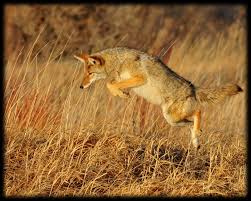By MARSHALL LEE WEIMER
Capital News Service
LANSING — New York officials recently warned people in that state to avoid Eastern coyotes.
“Coyotes may become more territorial during the breeding and pup-rearing seasons, which in New York run from January through March, increasing the risk for potential conflicts with people and pets,” state Department of Environmental Conservation Commissioner Basil Seggos said.
And the New York City Parks Department says, “Recent sightings confirm that coyotes live in New York City and are active in the Bronx.”
That’s no surprise to Michigan residents, who have witnessed a growth in the state’s coyote population in cities and suburbs – including Metro Detroit communities – as well as in rural areas.
The Eastern coyote is a hybrid between Great Lakes grey wolves and western coyotes that migrated east during the mid-1800s, according to the National Park Service.
“They are active day and night, but most active around sunrise and sunset,” says the Department of Natural Resources (DNR), which classifies them as “nuisance animals” on its website. “They are abundant in areas where adequate food, cover and water are available.
“Breeding takes place January – March and people are more likely to see and hear coyotes during this time,” the DNR says.
Michigan has hunting and trapping seasons for coyotes. Outside regular seasons, DNR says, landowners or their designees can kill them on private land without a fur harvester license if they are “doing or about to do damage to private property, pets, livestock or humans.”
New York’s recently issued guidance aims to avoid negative interactions between humans and Eastern coyotes while teaching residents to respect coyotes’ space. It encourages people to not feed coyotes or leave food outside and to teach children to appreciate coyotes from a distance.
“Education and communication are essential,” said Shawn Riley, a professor of wildlife management at Michigan State University.
Any human-wildlife conflict should be framed as a tolerance level, not a constant battle, Riley said.
The more commonplace wildlife is, the higher people’s tolerance to its presence, he said, and negative interactions between people and animals lead to changes in that tolerance.
Coyotes are opportunistic carnivores and habitat generalists, able to take advantage of human encroachment into natural areas, Sharon Poessel, a wildlife biologist at the US Geological Survey reported in a 2013 study. The study published in the journal Wildlife Society analyzed the interactions between Denver residents and coyotes.

U.S. Fish & Wildlife Service.
Eastern coyoteGenerally, coyotes can live close to humans with little threat to people, the study said. However, conflicts, especially with pets, can make people less tolerant of the animal.
Poessel’s study found coyote observations and conflicts are highest during December–March and lowest during July–September.
The Urban Coyote Research Project in the Chicago area advises the public not to create conflict where no conflict exists.
“If a coyote is acting as a coyote should by avoiding humans and pets, do not seek out opportunities to haze or otherwise aggravate the animal. Embracing communal respect is key,” it says.
It also recommends that “when a coyote fails to exhibit fear of humans or acts aggressively, the animal should be reported as soon as possible to the appropriate officials.”
Riley said guidance is important to prevent conflicts. The burden of wildlife management is to prove humans and nature can coexist by mitigating negative interactions before they occur, he said.
“An ounce of prevention is worth a ton of treatment.”
Marshall Lee Weimer writes for Great Lakes Echo.